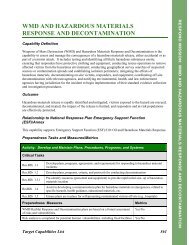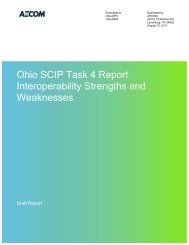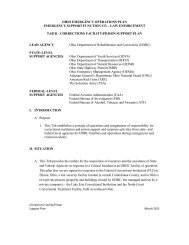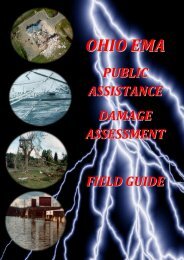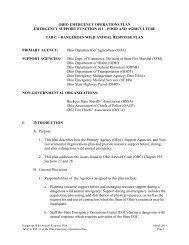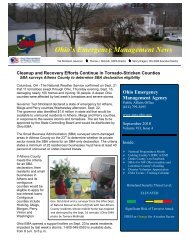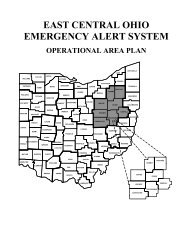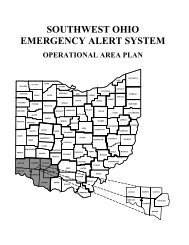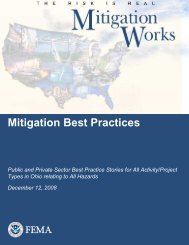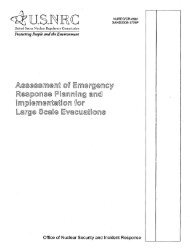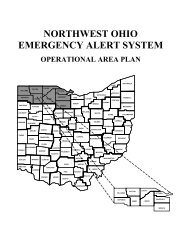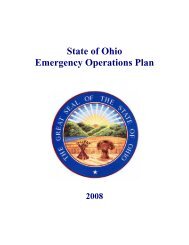Citizen Evacuation and Shelter-in-Place - Ohio Emergency ...
Citizen Evacuation and Shelter-in-Place - Ohio Emergency ...
Citizen Evacuation and Shelter-in-Place - Ohio Emergency ...
You also want an ePaper? Increase the reach of your titles
YUMPU automatically turns print PDFs into web optimized ePapers that Google loves.
CITIZEN EVACUATION AND SHELTER-IN-PLACECapability Def<strong>in</strong>ition<strong>Citizen</strong> evacuation <strong>and</strong> shelter-<strong>in</strong>-place is the capability to prepare for, ensure communication of, <strong>and</strong>immediately execute the safe <strong>and</strong> effective shelter<strong>in</strong>g-<strong>in</strong>-place of an at-risk population (<strong>and</strong> companionanimals), <strong>and</strong>/or the organized <strong>and</strong> managed evacuation of the at-risk population (<strong>and</strong> companionanimals) to areas of safe refuge <strong>in</strong> response to a potentially or actually dangerous environment. Inaddition, this capability <strong>in</strong>volves the safe reentry of the population where feasible.OutcomeAffected <strong>and</strong> at-risk populations (<strong>and</strong> companion animals to the extent necessary to save human lives) aresafely sheltered-<strong>in</strong>-place or evacuated to safe refuge areas.Relationship to National Response Plan <strong>Emergency</strong> Support Function(ESF)/AnnexThis capability is supported by the follow<strong>in</strong>g <strong>Emergency</strong> Support Functions (ESFs):ESF #1: TransportationESF #5: <strong>Emergency</strong> ManagementESF #6: Mass Care, Hous<strong>in</strong>g, <strong>and</strong> Human ServicesESF #8: Public Health <strong>and</strong> Medical ServicesESF #14: Public SafetyESF #15: External AffairsPreparedness Tasks <strong>and</strong> Measures/MetricsActivity: Develop <strong>and</strong> Ma<strong>in</strong>ta<strong>in</strong> Plans, Procedures, Programs, <strong>and</strong> SystemsCritical TasksRes.B.3a 1Res.B.3a 1.2.1Res.B3a 1.1.1.1Res.B3a 1.1.1.2ResB3a 1.1.1.3Develop plans, procedures, <strong>and</strong> protocols to manage evacuations <strong>and</strong> shelter<strong>in</strong>g-<strong>in</strong>-placeDevelop evacuation procedures for populations <strong>and</strong> locations at risk (<strong>in</strong>clud<strong>in</strong>g high density areas,neighborhoods, high-rise build<strong>in</strong>gs, subways, airports, special events venues, etc.), <strong>and</strong><strong>in</strong>stitutions that should beg<strong>in</strong> evacuations early (e.g., hospitals, nurs<strong>in</strong>g homes, long-term carefacilities, <strong>and</strong> correctional facilitiesDevelop <strong>and</strong> distribute public education materials on evacuation/shelter-<strong>in</strong>-place preparation,plans, <strong>and</strong> proceduresParticipate <strong>in</strong> citizen preparedness activities to ensure that public <strong>in</strong>formation onevacuation/shelter-<strong>in</strong>-place preparation <strong>and</strong> processes is effectively communicatedDevelop <strong>and</strong> implement programs to tra<strong>in</strong> local citizens on evacuation, reentry <strong>and</strong> shelter-<strong>in</strong>placeprocessesRESPOND MISSION: CITIZEN EVACUATION AND SHELTER-IN-PLACETarget Capabilities List 377
RESPOND MISSION: CITIZEN EVACUATION AND SHELTER-IN-PLACERes.B3a 1.1.3Res.B3a 1.3.1Res.B3a 1.3.1.1Res.B3a 1.3.1.2Res.B3a 1.3.2Res.B3a 1.3.3Res.B3a 1.3.4Res.B3a 1.4.1Res.B3a 1.4.3.1Res.B3a 1.4.4Res.B3a 1.4.5Res.B3a 1.4.6Res.B3a 1.4.7Res.B3a 1.2.4Preparedness MeasuresParticipate <strong>in</strong> establishment of public <strong>in</strong>formation announcements to be issued as part ofevacuation/shelter-<strong>in</strong>-place ordersDevelop <strong>and</strong> implement plans <strong>and</strong> procedures to identify <strong>in</strong> advance populations requir<strong>in</strong>gassistance dur<strong>in</strong>g evacuation/shelter-<strong>in</strong>-placeEstablish registry of populations requir<strong>in</strong>g assistance dur<strong>in</strong>g evacuation/shelter<strong>in</strong>g-<strong>in</strong>-placeDevelop <strong>and</strong> implement procedures to identify <strong>and</strong> arrange for transportation to accommodateimmobilized <strong>in</strong>dividuals or others requir<strong>in</strong>g special assistance dur<strong>in</strong>g transportDevelop plans <strong>and</strong> procedures for identify<strong>in</strong>g dur<strong>in</strong>g an <strong>in</strong>cident those populations requir<strong>in</strong>gassistance with evacuation, <strong>in</strong>clud<strong>in</strong>g identification of type of assistance requiredEstablish processes to ensure that immobilized <strong>and</strong> other <strong>in</strong>dividuals require special assistance canbe moved to collection po<strong>in</strong>ts for evacuationEstablish processes for identify<strong>in</strong>g <strong>and</strong> collect<strong>in</strong>g <strong>in</strong>dividuals who do not go to collection po<strong>in</strong>tsPre-identify evacuee collection po<strong>in</strong>ts <strong>and</strong> stag<strong>in</strong>g/reception areas (for immediateshelter<strong>in</strong>g/process<strong>in</strong>g)Pre-arrange contracts <strong>and</strong> agreements to ensure provision of transportation vehicle <strong>and</strong> driversdur<strong>in</strong>g an <strong>in</strong>cidentIdentify <strong>and</strong> arrange for the stag<strong>in</strong>g <strong>and</strong> use of resources from outside the plann<strong>in</strong>g areaDevelop plans <strong>and</strong> procedures to get resources to those who have sheltered <strong>in</strong> place (long term—3days or more)Develop plans <strong>and</strong> procedures for coord<strong>in</strong>at<strong>in</strong>g with other agencies to meet basic needs dur<strong>in</strong>gevacuationDevelop agreements with neighbor<strong>in</strong>g areas regard<strong>in</strong>g the movement <strong>and</strong> receipt of evacueesfrom the affected areaDevelop plans <strong>and</strong> procedures for evacuation/shelter-<strong>in</strong> place of companion animals<strong>Evacuation</strong> <strong>and</strong> shelter-<strong>in</strong>-place plans address the development <strong>and</strong> dissem<strong>in</strong>ation of accurate,timely, accessible <strong>in</strong>formation to public, media, support agenciesInformational materials for use <strong>in</strong> citizen preparedness for evacuation <strong>and</strong> shelter-<strong>in</strong>-place havebeen developed <strong>and</strong> coord<strong>in</strong>ated with public education/citizen preparedness programs onprocedures <strong>and</strong> guidance for radiological <strong>and</strong> nuclear hazardsInformational materials for use <strong>in</strong> citizen preparedness for evacuation <strong>and</strong> shelter-<strong>in</strong>-place havebeen developed <strong>and</strong> coord<strong>in</strong>ated with public education/citizen preparedness programs onprocedures <strong>and</strong> guidance for biological <strong>and</strong> chemical hazardsInformational materials for use <strong>in</strong> citizen preparedness for evacuation <strong>and</strong> shelter-<strong>in</strong>-place havebeen developed <strong>and</strong> coord<strong>in</strong>ated with public education/citizen preparedness programs onprocedures <strong>and</strong> guidance for explosive hazardsInformational materials for use <strong>in</strong> citizen preparedness for evacuation <strong>and</strong> shelter-<strong>in</strong>-place havebeen developed <strong>and</strong> coord<strong>in</strong>ated with public education/citizen preparedness programs on citizenresponsibilitiesInformational materials for use <strong>in</strong> citizen preparedness for evacuation <strong>and</strong> shelter-<strong>in</strong>-place havebeen developed <strong>and</strong> coord<strong>in</strong>ated with public education/citizen preparedness programs on options<strong>and</strong> guidance for the h<strong>and</strong>l<strong>in</strong>g of companion animalsPlann<strong>in</strong>g <strong>and</strong> <strong>in</strong>formational materials to be released to the public for evacuation or shelter<strong>in</strong>g <strong>in</strong>MetricsYes/NoYes/NoYes/NoYes/NoYes/NoYes/NoYes/No378 Target Capabilities List
place have been shared with the servic<strong>in</strong>g public safety communication centers <strong>and</strong> PublicService Answer<strong>in</strong>g Po<strong>in</strong>ts (PSAPs)Plans address<strong>in</strong>g authority <strong>and</strong> decision-mak<strong>in</strong>g processes for shelter-<strong>in</strong>-place <strong>and</strong>/or evacuationsare <strong>in</strong> placeNonprofit organizations/NGOs (e.g. the American Red Cross, Salvation Army, faith-basedorganizations) were actively engaged <strong>in</strong> plan developmentPlans address<strong>in</strong>g authority <strong>and</strong> procedures to declare <strong>and</strong> enforce a m<strong>and</strong>atory evacuation are <strong>in</strong>placePlans are <strong>in</strong> place for the evacuation of neighborhoodsPlans are <strong>in</strong> place for the evacuation of high-rise build<strong>in</strong>gsPlans are <strong>in</strong> place for the evacuation of subwaysPlans are <strong>in</strong> place for the evacuation of airportsPlans are <strong>in</strong> place for the evacuation of correctional facilitiesPlans are <strong>in</strong> place for the evacuation of hospitals/nurs<strong>in</strong>g homes/assisted-liv<strong>in</strong>g/elder carefacilitiesPlans are <strong>in</strong> place for the evacuation of special events venuesPlans are <strong>in</strong> place for the evacuation of other high-risk areas <strong>in</strong> response to a threat or attackPlans are <strong>in</strong> place for the evacuation of animal shelters <strong>and</strong> zoosProcesses for identify<strong>in</strong>g populations that may need assistance with evacuation/shelter-<strong>in</strong>-place,prior to an <strong>in</strong>cident are <strong>in</strong> placeProcesses for identify<strong>in</strong>g, dur<strong>in</strong>g an <strong>in</strong>cident, populations that may need assistance withevacuation/shelter-<strong>in</strong>-place are <strong>in</strong> placeProcesses for identify<strong>in</strong>g <strong>and</strong> address<strong>in</strong>g the different types of assistance needed (e.g., physicalmovement, transportation assistance, language translation, etc.) are <strong>in</strong> placePopulations that may need assistance with evacuation/shelter-<strong>in</strong>-place have been identified<strong>Evacuation</strong> plan(s) are <strong>in</strong> place to provide transportation <strong>and</strong> other evacuation assistance to allpersons who need evacuation assistance; plans, at a m<strong>in</strong>imum, address assistance for non<strong>in</strong>stitutionalizedpopulations requir<strong>in</strong>g assistance to be moved (e.g., the elderly, disabled, etc.)<strong>Evacuation</strong> plan(s) are <strong>in</strong> place to provide transportation <strong>and</strong> other evacuation assistance to allpersons who need evacuation assistance; plans, at a m<strong>in</strong>imum, address assistance for transientpopulations (e.g., the homeless; tourists <strong>and</strong> visitors)<strong>Evacuation</strong> plan(s) are <strong>in</strong> place to provide transportation <strong>and</strong> other evacuation assistance to allpersons who need evacuation assistance; plans, at a m<strong>in</strong>imum, address assistance for<strong>in</strong>stitutionalized populations (e.g., nurs<strong>in</strong>g homes, hospitals, psychiatric <strong>in</strong>stitutions, board<strong>in</strong>gschools)<strong>Evacuation</strong> plan(s) are <strong>in</strong> place to provide transportation <strong>and</strong> other evacuation assistance to allpersons who need evacuation assistance; plans, at a m<strong>in</strong>imum, address assistance for populationsout of the home (e.g., students, those <strong>in</strong> public venues) <strong>and</strong> the work force dur<strong>in</strong>g a surprise<strong>in</strong>cident<strong>Evacuation</strong> plan(s) are <strong>in</strong> place to provide transportation <strong>and</strong> other evacuation assistance to allpersons who need evacuation assistance; plans, at a m<strong>in</strong>imum, address assistance for companionanimalsPlans for coord<strong>in</strong>at<strong>in</strong>g with law enforcement (e.g. to identify risk to transportation <strong>in</strong>frastructureYes/NoYes/NoYes/NoYes/NoYes/NoYes/NoYes/NoYes/NoYes/NoYes/NoYes/NoYes/NoYes/NoYes/NoYes/NoYes/NoYes/NoYes/NoYes/NoYes/NoYes/NoYes/NoRESPOND MISSION: CITIZEN EVACUATION AND SHELTER-IN-PLACETarget Capabilities List 379
Pre-event exercises of the notification <strong>and</strong> activation of evacuation <strong>and</strong> shelter-<strong>in</strong>-place plansare conducted with citizen participationLocal emergency response agencies/staff <strong>in</strong>clud<strong>in</strong>g public safety answer<strong>in</strong>g po<strong>in</strong>ts, aretra<strong>in</strong>ed on local evacuation/shelter-<strong>in</strong>-place strategiesYes/NoYes/NoPerformance Tasks <strong>and</strong> Measures/MetricsActivity: Direct <strong>Evacuation</strong> <strong>and</strong>/or In-<strong>Place</strong> Protection Tactical OperationsDef<strong>in</strong>ition: In response to a hazardous condition for a locality, direct, manage, <strong>and</strong> coord<strong>in</strong>ateevacuation <strong>and</strong>/or <strong>in</strong>-place shelter<strong>in</strong>g procedures for both the general population <strong>and</strong> thoserequir<strong>in</strong>g evacuation assistance throughout <strong>in</strong>cidentCritical TasksRes.B3a 3.1.2Res.B3a 3.1.3Res.B3a 3.1.4Res.B3a 3.2.1Res.B3a 3.2Res.B3a 3.4.4Res.B3a 3.3Res.B3a 3.3.2Res.B3a 3.3.1Res.B3a 3.4.2Res.B3a 3.3.1.1Res.B3a 3.4.1Res.B3a 3.3.4Res.B3a 3.3.3Res.B3a 3.4.5Res.B3a 3.5.3Res.B3a 3.5.4Res.B3a 3.6Identify populations, <strong>in</strong>stitutions (e.g., hospitals, nurs<strong>in</strong>g homes, correctional facilities) <strong>and</strong>locations to be evacuated or sheltered-<strong>in</strong>-placeCoord<strong>in</strong>ate with law enforcement to identify risk (e.g., from a potential terrorist attack) totransportation <strong>in</strong>frastructure that may be used for evacuationCoord<strong>in</strong>ate with law enforcement to anticipate secondary attack, <strong>and</strong> identify security <strong>and</strong>survival vulnerabilities of the evacuated or sheltered population <strong>and</strong> protective countermeasuresIdentify appropriate decision mak<strong>in</strong>g authority responsible for decid<strong>in</strong>g a course of action toaddress the <strong>in</strong>cidentDeterm<strong>in</strong>e appropriate course of action to address the <strong>in</strong>cidentCoord<strong>in</strong>ate with serv<strong>in</strong>g Public Service Answer<strong>in</strong>g Po<strong>in</strong>ts regard<strong>in</strong>g communication of theevacuation <strong>and</strong>/or shelter-<strong>in</strong>-place decisionRe-assess evacuation/shelter-<strong>in</strong>-place plans <strong>and</strong> beg<strong>in</strong> implementationRe-assess location of evacuation collection po<strong>in</strong>ts <strong>and</strong> stag<strong>in</strong>g areas identified <strong>in</strong> plans <strong>and</strong> adjustas neededRe-assess evacuation traffic management plan <strong>and</strong> adjust as neededCoord<strong>in</strong>ate with mass care, medical, <strong>and</strong> other services to set up evacuation stag<strong>in</strong>g areasRe-assess emergency evacuation routes <strong>and</strong> adjust as neededCoord<strong>in</strong>ate with transportation agencies to implement evacuation plansCoord<strong>in</strong>ate with mass care services to identify location of shelter facilities <strong>and</strong> other mass careservices for evacueesCoord<strong>in</strong>ate with mass care agencies to assess the need for emergency feed<strong>in</strong>g <strong>and</strong> shelter<strong>in</strong>gactivitiesCoord<strong>in</strong>ate with appropriate agencies regard<strong>in</strong>g car<strong>in</strong>g for companion animals <strong>in</strong> transitCoord<strong>in</strong>ate medical assistance for special need evacuees <strong>in</strong> transitNotify appropriate agencies of anticipated medical assistance required upon arrival at temporarylocations (stag<strong>in</strong>g area, shelters, etc)Coord<strong>in</strong>ate with HazMat to conduct decontam<strong>in</strong>ation of evacuees, <strong>in</strong>clud<strong>in</strong>g those withdisabilities <strong>and</strong> medical needs (<strong>in</strong>clud<strong>in</strong>g their equipment)RESPOND MISSION: CITIZEN EVACUATION AND SHELTER-IN-PLACETarget Capabilities List 381
Res.B3a 3.7Coord<strong>in</strong>ate with environmental health to monitor progress of affected area to determ<strong>in</strong>e when reentryis deemed appropriatePerformance MeasuresMetricRESPOND MISSION: CITIZEN EVACUATION AND SHELTER-IN-PLACEIndividual(s) with authority to select protective strategy is identifiedIndividual(s) with authority identifies the <strong>in</strong>formation needed to make decision(s)Necessary <strong>in</strong>formation is gatheredAppropriate <strong>and</strong> available strategies are identifiedAn appropriate strategy is selected <strong>and</strong> communicatedAppropriate protective strategy to meet the potential risk/danger to the variouspopulations is selected with<strong>in</strong> appropriate timeframe<strong>Citizen</strong> protection decision is coord<strong>in</strong>ated with surround<strong>in</strong>g jurisdictions to supportevacuation routes, <strong>and</strong> activate reception facilities <strong>and</strong> sheltersRe-entry plann<strong>in</strong>g is conducted dur<strong>in</strong>g the course of response to the eventActivity: Activate <strong>Evacuation</strong> <strong>and</strong>/or In-<strong>Place</strong> ProtectionYes/NoYes/NoYes/NoYes/NoYes/NoYes/NoYes/NoYes/NoDef<strong>in</strong>ition: In response to activation, identify <strong>and</strong> ensure notification of at-risk populations, <strong>and</strong>identify populations requir<strong>in</strong>g assistance <strong>in</strong> evacuation <strong>and</strong>/or <strong>in</strong>-place protectionCritical TasksRes.B3a 4.1Res.B3a 4.2.1Res.B3a 4.2.3Res.B3a 4.2.4Res.B3a 4.4.1Res.B3a 4.4.2Res.B3a 4.4.3Res.B3a 4.5Res.B3a 4.3Performance MeasuresIdentify <strong>and</strong> mobilize appropriate personnelIssue shelter-<strong>in</strong>-place orderIssue evacuation orderCoord<strong>in</strong>ate with agencies provid<strong>in</strong>g emergency public <strong>in</strong>formation <strong>and</strong> warn<strong>in</strong>g to ensureeffective communication of evacuation/shelter-<strong>in</strong>-place order <strong>and</strong> proceduresDeterm<strong>in</strong>e locations of populations who may need assistance with evacuation from affected area(e.g., us<strong>in</strong>g pre-established registry of populations <strong>in</strong> facilities)Implement plan to capture self-report<strong>in</strong>g by those requir<strong>in</strong>g assistance with evacuation (e.g., viahot-l<strong>in</strong>e)Conduct triage upon identification to determ<strong>in</strong>e type of assistance requiredImplement systems for track<strong>in</strong>g evacuees <strong>and</strong> those who shelter <strong>in</strong> placeImplement notification protocols for communication to Public Service Answer<strong>in</strong>g Po<strong>in</strong>ts (911centers)Time <strong>in</strong> which affected population is notified of shelter-<strong>in</strong>-place orderThe most affected populations for evacuation are notified first (e.g., r<strong>in</strong>gevacuations)Percent of population appropriately notified of evacuation procedures, routes,locations, <strong>and</strong> sources of evacuation <strong>in</strong>formation throughout the <strong>in</strong>cidentMetricWith<strong>in</strong> 15 m<strong>in</strong>utes from orderto shelter-<strong>in</strong>-placeYes/No100%382 Target Capabilities List
Percent of population requir<strong>in</strong>g assistance that has been identified 100%Activity: Implement <strong>Evacuation</strong> Orders for General PopulationDef<strong>in</strong>ition: Assist the self-evacuation of affected population by provid<strong>in</strong>g public <strong>in</strong>formation <strong>and</strong><strong>in</strong>structions, traffic control, <strong>and</strong> support services to evacuees along evacuation routesCritical TasksRes.B3a 5.1Res.B3a 5.2Res.B3a 5.2.1Res.B3a 5.1.2Res.B3a 5.4.3Res.B3a 5.3Res.B3a 5.4.1Res.B3a 5.4.2Performance MeasuresProvide public notification agencies with <strong>in</strong>formation to provide <strong>in</strong>structions for evacuationActivate approved traffic control planCoord<strong>in</strong>ate with appropriate agencies regard<strong>in</strong>g support for traffic controlProvide <strong>in</strong>formation regard<strong>in</strong>g evacuation stag<strong>in</strong>g area locationImplement procedures for allow<strong>in</strong>g voluntary track<strong>in</strong>g of evacuees who participate voluntarilyMonitor evacuation traffic flow/dem<strong>and</strong> <strong>and</strong> adjust evacuation traffic management plan <strong>and</strong>measures as appropriateProvide services (e.g., gas, food, water, tow trucks, etc.) along the evacuation route(s)Monitor evacuation traffic to identify those no longer able to self-evacuate <strong>and</strong> requir<strong>in</strong>gspecialized assistanceFrequency with which public is <strong>in</strong>itially notified of evacuation procedures, routes,locations, or sources of evacuation <strong>in</strong>formationFrequency with which public is notified of evacuation procedures, routes, locations, orsources of evacuation <strong>in</strong>formation throughout the <strong>in</strong>cident.Time <strong>in</strong> which the traffic <strong>and</strong> transportation plan is implemented to enable evacuationwith<strong>in</strong> the <strong>in</strong>cident timeframeTime <strong>in</strong> which the evacuation of the affected general population for an event withadvanced warn<strong>in</strong>g is completedActivity: Collect <strong>and</strong> Evacuate Population Requir<strong>in</strong>g AssistanceMetricEvery 30 m<strong>in</strong>utesEvery 2 hoursWith<strong>in</strong> 3 hours fromevacuation orderWith<strong>in</strong> 72 hours fromthe order to evacuateDef<strong>in</strong>ition: Upon identification of <strong>in</strong>dividuals requir<strong>in</strong>g assistance <strong>and</strong> type of assistancerequired, collect <strong>and</strong> move <strong>in</strong>dividuals to established evacuation stag<strong>in</strong>g/reception area for furtherservicesCritical TasksRes.B3a 6.1Res.B3a 6.1.1Res.B3a 6.1.2Res.B3a 6.2.3Order transportation services for evacuationCoord<strong>in</strong>ate with support<strong>in</strong>g agencies <strong>and</strong> pre-arranged providers to obta<strong>in</strong> appropriate means oftransportation for those requir<strong>in</strong>g transportation assistance (e.g., buses, ambulances, h<strong>and</strong>icapassistedvans)Implement plans for provid<strong>in</strong>g alternative means of transport for immobilized <strong>in</strong>dividuals orthose need<strong>in</strong>g other special assistance <strong>in</strong> transitProvide appropriate specialized transportation services for those requir<strong>in</strong>g additional supportdur<strong>in</strong>g evacuationRESPOND MISSION: CITIZEN EVACUATION AND SHELTER-IN-PLACETarget Capabilities List 383
RESPOND MISSION: CITIZEN EVACUATION AND SHELTER-IN-PLACERes.B3a 6.2.4Res.B3a 6.3.1Res.B3a 6.3.2Performance MeasuresCoord<strong>in</strong>ate provision of medical support services for evacuat<strong>in</strong>g special needs populationsCollect <strong>in</strong>dividuals at pre-established collection po<strong>in</strong>ts <strong>and</strong> transfer to stag<strong>in</strong>g/reception areaCollect <strong>in</strong>dividuals at non-specified locations <strong>and</strong> transfer to stag<strong>in</strong>g/reception areaPercent of requests for evacuation assistance for those <strong>in</strong> need that are met <strong>in</strong> accordance withestablished proceduresProcedures for obta<strong>in</strong><strong>in</strong>g evacuation assistance are publicized to general publicPercent of service organizations follow<strong>in</strong>g established procedures to provide evacuationassistanceSources of surge transportation assistance for evacuations are contacted <strong>and</strong> provided<strong>in</strong>formation on their roleSources of assistance to evacuated persons with special needs are contacted <strong>and</strong> provided<strong>in</strong>formation on their roleSpecific arrangements for medical support services for evacuation of those requir<strong>in</strong>g it areimplementedTransportation assistance is provided for/by hospitals, nurs<strong>in</strong>g homes <strong>and</strong> other <strong>in</strong>stitutions thatwill need to evacuate or help/evacuate those <strong>in</strong> their careCollection po<strong>in</strong>ts for <strong>in</strong>dividuals need<strong>in</strong>g special evacuation assistance are established <strong>and</strong>publicizedActivity: Operate <strong>Evacuation</strong> Stag<strong>in</strong>g/Reception AreaMetric100%Yes/No100%Yes/NoYes/NoYes/NoYes/NoYes/NoDef<strong>in</strong>ition: In coord<strong>in</strong>ation with mass care, medical, <strong>and</strong> other service agencies, provideimmediate basic needs <strong>and</strong> process<strong>in</strong>g of evacuated <strong>in</strong>dividuals en route to other dest<strong>in</strong>ations(e.g., to shelters, hospitals, etc.)Critical TasksRes.B3a 7.1Res.B3a 7.1.1Res.B3a 7.2.1Res.B3a 7.2.2Res.B3a 7.2.3Res.B3a 7.2.4Res.B3a 7.3.1Res.B3a 7.3.2Establish evacuation stag<strong>in</strong>g/reception areaConduct security sweeps of evacuation stag<strong>in</strong>g/reception areas prior to occupancy, if <strong>in</strong>cident is aterrorist attack or suspected terrorist attackProvide, <strong>in</strong> coord<strong>in</strong>ation with mass care, for basic needs support <strong>and</strong> process<strong>in</strong>g of evacuated<strong>in</strong>dividuals <strong>and</strong> companion animals <strong>in</strong> preparation for further movementProvide, <strong>in</strong> coord<strong>in</strong>ation with medical care, access to medical services for evacuated <strong>in</strong>dividuals<strong>in</strong> stag<strong>in</strong>g/reception areaProvide, <strong>in</strong> coord<strong>in</strong>ation with WMD <strong>and</strong> Hazardous Materials Response capability, fordecontam<strong>in</strong>ation of evacuated <strong>in</strong>dividuals if necessary (<strong>in</strong>clud<strong>in</strong>g those with medical needs)Coord<strong>in</strong>ate with appropriate agencies to address needs of those requir<strong>in</strong>g assistanceProvide track<strong>in</strong>g of people need<strong>in</strong>g evacuation assistanceProvide voluntary registration/track<strong>in</strong>g system for general population to support reunificationPerformance MeasuresMetric384 Target Capabilities List
Percent of evacuation stag<strong>in</strong>g/reception areas <strong>in</strong> the affected area that are coord<strong>in</strong>ated withnecessary sites <strong>and</strong> assist<strong>in</strong>g agenciesPublic <strong>in</strong>formation messages regard<strong>in</strong>g evacuation stag<strong>in</strong>g/reception areas are prepared <strong>and</strong>dissem<strong>in</strong>ated100%Yes/NoPercent of evacuees whose basic needs are addressed at the stag<strong>in</strong>g area 100%Activity: Manage Incom<strong>in</strong>g EvacueesDef<strong>in</strong>ition: In coord<strong>in</strong>ation with other service agencies, provide short-term <strong>and</strong> long-term supportto evacuees arriv<strong>in</strong>g from affected areasCritical TasksRes.B3a 8.1Res.B3a 8.2Res.B3a 8.3Res.B3a 8.4Performance MeasuresEstablish reception areas/centers for evacuees <strong>in</strong> the host jurisdictionMonitor traffic movement of self-evacuees <strong>in</strong>to/through area, <strong>and</strong> redirect as necessaryCoord<strong>in</strong>ate with support agencies to provide short-term needs for evacuees, such as directions,<strong>in</strong>formation, shelter, medical care, <strong>and</strong> other assistancePlan, <strong>in</strong> coord<strong>in</strong>ation with social service agencies, for long-term support for evacuees (e.g.,temporary hous<strong>in</strong>g, schools, job searches, etc.)Percent of evacuation stag<strong>in</strong>g/reception areas <strong>in</strong> the host jurisdiction that are coord<strong>in</strong>atedwith necessary authorities <strong>and</strong> assist<strong>in</strong>g agenciesPublic <strong>in</strong>formation messages to publicize evacuation stag<strong>in</strong>g/reception areas <strong>in</strong> the hostjurisdiction are prepared <strong>and</strong> dissem<strong>in</strong>atedProcess<strong>in</strong>g, registration <strong>and</strong> track<strong>in</strong>g systems are established with procedures, necessaryforms <strong>and</strong> materials, <strong>and</strong> tra<strong>in</strong>ed staffPlans are completed <strong>and</strong> arrangements established to provide necessary care, shelter,lodg<strong>in</strong>g <strong>and</strong> short term needs of evacueesActivity: Implement In-<strong>Place</strong> Protection ProceduresMetric100%Yes/NoYes/NoYes/NoDef<strong>in</strong>ition: Upon <strong>in</strong>-place protection activation, assist at-risk population <strong>in</strong> shelter<strong>in</strong>g <strong>in</strong> homes ordesignated <strong>in</strong>-place shelter<strong>in</strong>g locationsCritical TasksRes.B3a 9.2Res.B3a 9.3.1Res.B3a 9.3.2Performance MeasuresIdentify steps to reduce <strong>in</strong>filtration of hazard(s)Ensure access to emergency communications while sheltered-<strong>in</strong>-placeUse emergency alerts system <strong>and</strong> Public Service Answer<strong>in</strong>g Po<strong>in</strong>ts (PSAPs) to advise <strong>and</strong> update<strong>in</strong>formation of <strong>in</strong>cidentMetricRESPOND MISSION: CITIZEN EVACUATION AND SHELTER-IN-PLACEPercent of affected population immediately notified of <strong>in</strong>itial <strong>in</strong>-place protectionprocedures, us<strong>in</strong>g st<strong>and</strong><strong>in</strong>g emergency <strong>in</strong>structions100%Target Capabilities List 385
Time <strong>in</strong> which the affected general population is sheltered <strong>in</strong> placeFrequency with which follow-on <strong>in</strong>structions are provided to sheltered-<strong>in</strong>-placepopulations (e.g., hazard mitigation recommendations)With<strong>in</strong> 30 m<strong>in</strong>utesfrom notificationCont<strong>in</strong>uousRESPOND MISSION: CITIZEN EVACUATION AND SHELTER-IN-PLACEActivity: Assist Re-EntryDef<strong>in</strong>ition: Upon notification of the affected area be<strong>in</strong>g safe, assist <strong>in</strong>-shelter population <strong>and</strong>/orevacuees <strong>in</strong> re-enter<strong>in</strong>g areaCritical TasksRes.B3a 10.1Res.B3a 10.2Res.B3a 10.3Res.B3a 10.4Performance MeasuresAdapt <strong>and</strong> implement reentry plans as officials announce areas with<strong>in</strong> the region to be approvedfor reentryAssist <strong>in</strong> the re-entry of people <strong>and</strong> pets <strong>in</strong>to evacuated areas when appropriate <strong>and</strong> safeProvide re-entry <strong>in</strong>formation to the public on a timely <strong>and</strong> on-go<strong>in</strong>g basisCoord<strong>in</strong>ate with appropriate agencies to provide <strong>in</strong>structions <strong>and</strong> <strong>in</strong>formation if re-entry is notfeasibleRe-entry plann<strong>in</strong>g is conducted dur<strong>in</strong>g the course of response to the eventMetricYes/NoPercent of affected evacuees notified of temporary re-entry procedures 100%Percent of affected evacuees <strong>in</strong>structed of permanent re-entry procedures, <strong>in</strong>clud<strong>in</strong>g safetyprecautionsActivity: Demobilize <strong>Citizen</strong> <strong>Evacuation</strong> <strong>and</strong> <strong>Shelter</strong>-In-<strong>Place</strong> Operations100%Def<strong>in</strong>ition: Upon completion of assigned duties, decontam<strong>in</strong>ate equipment, supplies, <strong>and</strong>personnel if appropriate, <strong>and</strong> demobilizeCritical TasksRes.B3a 11.1Res.B3a 11.2Res.B3a 11.3Performance MeasuresArrange for decontam<strong>in</strong>ation of equipment, supplies, <strong>and</strong> personnel used <strong>in</strong> evacuation/<strong>in</strong>-placeprotectionParticipate <strong>in</strong> <strong>in</strong>cident debrief<strong>in</strong>g on evacuation/<strong>in</strong>-place protection implementationRelease personnel support<strong>in</strong>g evacuation/<strong>in</strong>-place protectionMetricPercent of <strong>Citizen</strong> <strong>Evacuation</strong> <strong>and</strong>/or <strong>Shelter</strong>-In-<strong>Place</strong> personnel debriefed 100%Lessons learned are identifiedLessons learned are addressedYes/NoYes/No386 Target Capabilities List
L<strong>in</strong>ked CapabilitiesL<strong>in</strong>ked CapabilityRelationshipCommunityPreparedness <strong>and</strong>ParticipationOn-Site IncidentManagementWMD <strong>and</strong> HazardousMaterials Response <strong>and</strong>Decontam<strong>in</strong>ation<strong>Emergency</strong> OperationsCenter Management<strong>Emergency</strong> Public Safety<strong>and</strong> Security Response<strong>Emergency</strong> Triage <strong>and</strong>Pre-Hospital TreatmentMedical SurgeMass Care (<strong>Shelter</strong><strong>in</strong>g,Feed<strong>in</strong>g, <strong>and</strong> RelatedServices)<strong>Emergency</strong> PublicInformation <strong>and</strong> Warn<strong>in</strong>gEnvironmental Health<strong>Citizen</strong> <strong>Evacuation</strong> <strong>and</strong> <strong>Shelter</strong>-In-<strong>Place</strong> coord<strong>in</strong>ates with Community Preparedness <strong>and</strong>Participation to ensure that citizens are educated on how to prepare for <strong>and</strong> conductevacuation <strong>and</strong> shelter<strong>in</strong>g-<strong>in</strong>-place.<strong>Citizen</strong> <strong>Evacuation</strong> <strong>and</strong> <strong>Shelter</strong>-In-<strong>Place</strong> management <strong>in</strong>tegrates itself <strong>in</strong>to the localIncident Comm<strong>and</strong>/Unified Comm<strong>and</strong> system to coord<strong>in</strong>ate protective action decisions.<strong>Citizen</strong> <strong>Evacuation</strong> <strong>and</strong> <strong>Shelter</strong>-In-<strong>Place</strong> coord<strong>in</strong>ates with WMD <strong>and</strong> HazardousMaterials Response <strong>and</strong> Decontam<strong>in</strong>ation to ensure evacuation <strong>and</strong>/or <strong>in</strong>-placeprotection personnel <strong>and</strong> equipment are appropriately decontam<strong>in</strong>ated. WMD <strong>and</strong>Hazardous Materials Response <strong>and</strong> Decontam<strong>in</strong>ation also supports decontam<strong>in</strong>ation ofevacuees when necessary.<strong>Citizen</strong> <strong>Evacuation</strong> <strong>and</strong> <strong>Shelter</strong>-In-<strong>Place</strong> management works through the EOCManagement to notify affected <strong>and</strong> general population of protective action decisions.<strong>Citizen</strong> <strong>Evacuation</strong> <strong>and</strong> <strong>Shelter</strong>-In-<strong>Place</strong> relies upon <strong>Emergency</strong> Public Safety <strong>and</strong>Security Response assistance to safely maneuver affected populations throughevacuation routes <strong>and</strong> provide assistance for traffic <strong>and</strong> crowd control. <strong>Emergency</strong>Public Safety <strong>and</strong> Security Response also h<strong>and</strong>les the evacuation of the <strong>in</strong>carceratedpopulations at risk.<strong>Citizen</strong> <strong>Evacuation</strong> <strong>and</strong> <strong>Shelter</strong>-In-<strong>Place</strong> coord<strong>in</strong>ates with <strong>Emergency</strong> Triage <strong>and</strong> Pre-Hospital Treatment to obta<strong>in</strong> immediate medical treatment for evacuees <strong>in</strong> need, eitheren-route or at evacuee stag<strong>in</strong>g area.<strong>Citizen</strong> <strong>Evacuation</strong> <strong>and</strong> <strong>Shelter</strong>-In-<strong>Place</strong> coord<strong>in</strong>ates with Medical Surge to obta<strong>in</strong>immediate medical treatment for evacuees <strong>in</strong> need, either en-route or at evacuee stag<strong>in</strong>garea.<strong>Citizen</strong> <strong>Evacuation</strong> <strong>and</strong> <strong>Shelter</strong>-In-<strong>Place</strong> coord<strong>in</strong>ates with Mass Care to provide basicservices to evacuees <strong>and</strong> assists <strong>in</strong> transferr<strong>in</strong>g evacuees to Mass Care shelters for at-riskpopulations.<strong>Citizen</strong> <strong>Evacuation</strong> <strong>and</strong> <strong>Shelter</strong>-In-<strong>Place</strong> coord<strong>in</strong>ates with emergency public <strong>in</strong>formation<strong>and</strong> warn<strong>in</strong>g to provide accurate, timely <strong>and</strong> cont<strong>in</strong>uous <strong>in</strong>formation to the affected <strong>and</strong>general populations regard<strong>in</strong>g evacuation <strong>and</strong>/or shelter-<strong>in</strong>-place orders <strong>and</strong> procedures,<strong>and</strong> subsequent reentry <strong>in</strong>formation <strong>and</strong> <strong>in</strong>structions.<strong>Citizen</strong> <strong>Evacuation</strong> <strong>and</strong> <strong>Shelter</strong>-In-<strong>Place</strong> relies on Environmental Health for assessmentof hazards to determ<strong>in</strong>e whether areas are safe for re-entry.RESPOND MISSION: CITIZEN EVACUATION AND SHELTER-IN-PLACETarget Capabilities List 387
Capability Activity Process FlowL<strong>in</strong>kedCapabilitiesRelationshipStart: Indicationof need forprotective action<strong>Citizen</strong> <strong>Evacuation</strong> <strong>and</strong> <strong>Shelter</strong>-<strong>in</strong>-<strong>Place</strong> CapabilityRESPOND MISSION: CITIZEN EVACUATION AND SHELTER-IN-PLACEOn-Site IncidentManagement<strong>Emergency</strong>Operations CenterManagement<strong>Emergency</strong> PublicInformation <strong>and</strong>Warn<strong>in</strong>g<strong>Emergency</strong>PublicSafety <strong>and</strong>SecurityResponseMass Care(<strong>Shelter</strong><strong>in</strong>g,Feed<strong>in</strong>g, <strong>and</strong>RelatedServices)EnvironmentalHealthWMD/HazardousMaterialsResponse <strong>and</strong>Decontam<strong>in</strong>ation<strong>Emergency</strong> Triage<strong>and</strong>Pre-HospitalTreatmentMedical SurgeCommunityPreparedness<strong>and</strong>ParticipationInform ofprotective decisionsCoord<strong>in</strong>ate public <strong>in</strong>formationRequest supportPerimeters establishedCoord<strong>in</strong>ate evacuation of<strong>in</strong>carceratedCoord<strong>in</strong>ation shelters forevacuated citizensBasic needs at stag<strong>in</strong>g area metTest<strong>in</strong>g conductedEvacuees decontam<strong>in</strong>atedArea decontam<strong>in</strong>atedas appropriateTransfer <strong>in</strong>jured<strong>Citizen</strong>s educatedon evacuation <strong>and</strong>shelter-<strong>in</strong>-place proceduresDirect <strong>Citizen</strong><strong>Evacuation</strong> <strong>and</strong><strong>Shelter</strong>-<strong>in</strong>-<strong>Place</strong>TacticalOperationsPlann<strong>in</strong>gLogisticsComm.ManageCoord<strong>in</strong>ateSuperviseSafetyResourceRequestsProtective action decision madeCollect <strong>and</strong>EvacuatePopulationRequir<strong>in</strong>gAssistancePopulationevacuatedOperate<strong>Evacuation</strong>Stag<strong>in</strong>g/ReceptionAreasDecontam<strong>in</strong>ate areaPopulation requir<strong>in</strong>gassistance identifiedEvacueesprocessed/basicneeds metEnvironmental conditions deemed safeActivate <strong>Citizen</strong><strong>Evacuation</strong> <strong>and</strong><strong>Shelter</strong>-<strong>in</strong>-<strong>Place</strong>Implement<strong>Evacuation</strong> Ordersfor GeneralPopulationIs evacuationshort-term?Manage Incom<strong>in</strong>gEvacueesAssist Re-entryDemobilize <strong>Citizen</strong><strong>Evacuation</strong> <strong>and</strong><strong>Shelter</strong>-<strong>in</strong>-<strong>Place</strong>End: No need rema<strong>in</strong>s for moreprotective action decisionsReady to implement evacuation <strong>and</strong>/orshelter-<strong>in</strong>-placePopulationself-evacuatedNoSupportprovided <strong>in</strong>newlocationYes<strong>Citizen</strong>s allowed toreturn to their homesImplement In-<strong>Place</strong> ProtectionProceduresPopulation kept assafe as possibleundercircumstances388 Target Capabilities List
Resource Element DescriptionResource Elements<strong>Emergency</strong> Alert System (EAS)Public Warn<strong>in</strong>g SystemsTraffic control packagesTransportation vehiclesSecurity <strong>and</strong> law enforcementofficersNon-law enforcement trafficcontrollersSmall Animal Transport TeamsDOT <strong>Evacuation</strong> Coord<strong>in</strong>ationTeam (Type I, II, <strong>and</strong> III)DOT <strong>Evacuation</strong> Liaison TeamPlann<strong>in</strong>g AssumptionsGeneralComponents <strong>and</strong> DescriptionEstablished by the FCC <strong>in</strong> 1994 to provide the President with access tothous<strong>and</strong>s of broadcast stations, cable systems <strong>and</strong> participat<strong>in</strong>g satelliteprogrammers to transmit a message to the public.Other notification systems <strong>in</strong>clud<strong>in</strong>g sirens, call-out systems, televisioncaption<strong>in</strong>g system, <strong>and</strong> any system capable of reach<strong>in</strong>g 100% of the at-riskpopulation, <strong>in</strong>clud<strong>in</strong>g a redundant capabilityTeams of law enforcement personnel <strong>and</strong> traffic control equipment (barriers,cones, directional signals)Buses <strong>and</strong> other mass transit vehicles, <strong>in</strong>clud<strong>in</strong>g drivers, able to providetransportation to evacuees, <strong>in</strong>clud<strong>in</strong>g for re-entryTo provide traffic control, us<strong>in</strong>g legal authority alter traffic flow <strong>and</strong> use ofhighwaysOther persons, (non-law enforcement types, such as Volunteers <strong>in</strong> PoliceService) assigned traffic control duties at other <strong>in</strong>tersections direct<strong>in</strong>g trafficflowPer NIMSPer NIMS, facilitates the rapid, efficient, <strong>and</strong> safe evacuation of threatenedpopulationsPer NIMS, provides support <strong>in</strong> State <strong>and</strong> local emergency response efforts bycompil<strong>in</strong>g, analyz<strong>in</strong>g, <strong>and</strong> dissem<strong>in</strong>at<strong>in</strong>g traffic-related <strong>in</strong>formation that can beused to facilitate the rapid, efficient, <strong>and</strong> safe evacuation <strong>and</strong> reentry ofthreatened populations.• Although applicable to several of the 15 National Plann<strong>in</strong>g Scenarios, the capability factors weredeveloped from an <strong>in</strong>-depth analysis of the Chlor<strong>in</strong>e Tank Explosion scenario. Other scenarios werereviewed to identify required adjustments or additions to the plann<strong>in</strong>g factors <strong>and</strong> national targets.• This capability applies to a wide range of <strong>in</strong>cidents <strong>and</strong> emergencies, <strong>in</strong>clud<strong>in</strong>g accidental ordeliberate disease outbreaks, natural disasters, <strong>and</strong> nuclear <strong>and</strong> conventional events.• Large-scale evacuations, organized or self-directed, may occur. More people are <strong>in</strong>itially likely toflee <strong>and</strong> seek shelter for attacks <strong>in</strong>volv<strong>in</strong>g chemical, biological, radiological or nuclear agents than fornatural events.• <strong>Evacuation</strong> times <strong>and</strong> the frequency with which the public is notified of evacuation procedures areboth <strong>in</strong>cident driven. The times may change depend<strong>in</strong>g on whether it is an immediate or long termevacuation.• The time it takes to complete an evacuation is also <strong>in</strong>cident driven depend<strong>in</strong>g on the type of hazard.• Transportation <strong>and</strong> traffic routes will be severely <strong>and</strong> negatively affected by the evacuation• Many evacuees will require provision of transportation.• The health-related implications of an <strong>in</strong>cident may aggravate or impair attempts to implement acoord<strong>in</strong>ated evacuation management strategy.RESPOND MISSION: CITIZEN EVACUATION AND SHELTER-IN-PLACETarget Capabilities List 389
RESPOND MISSION: CITIZEN EVACUATION AND SHELTER-IN-PLACE• Public anxiety <strong>and</strong> stress will result from evacuations, requir<strong>in</strong>g mental health services, appropriaterisk communications, <strong>and</strong> public education/<strong>in</strong>struction.• Local jurisdictional resources will be quickly overwhelmed <strong>and</strong> will require mutual aid from otherjurisdictions <strong>and</strong> support from Federal, State, <strong>and</strong> regional agencies.• Through memor<strong>and</strong>a of underst<strong>and</strong><strong>in</strong>g (MOUs) <strong>in</strong>corporated <strong>in</strong>to plann<strong>in</strong>g, adjacent communitieswill be prepared to h<strong>and</strong>le significant numbers of evacuees from affected areas. These hostcommunities also will identify resources, personnel, <strong>and</strong> equipment to shelter <strong>and</strong> support evacuees.• Pre-event identification of shelter sites has been planned for by emergency management agencies <strong>and</strong>MOUs are <strong>in</strong> place for use of the facilities.• Although shelters will require a m<strong>in</strong>imum time for setup <strong>and</strong> activation, populations will requireservices immediately on evacuation, notably those for special needs populations <strong>and</strong> conta<strong>in</strong>ment.• For shelter-<strong>in</strong>-place, evacuation, shelter<strong>in</strong>g, <strong>and</strong> reentry plann<strong>in</strong>g, each jurisdiction has unique hazards<strong>and</strong> unique resources. Capabilities for at-risk populations are based on jurisdictional hazardvulnerability analysis. Plans (<strong>in</strong>clud<strong>in</strong>g emergency operations plans), procedures, mutual aidagreement, <strong>and</strong> so forth must be <strong>in</strong> place to support effective evacuation <strong>and</strong> shelter<strong>in</strong>g, dependent onthe hazard/risk analysis <strong>and</strong> the resources available for the at-risk population. The measurement forthis capability is: Can the jurisdiction evacuate <strong>and</strong>/or shelter the at-risk population <strong>and</strong>, if theycannot, what actions will procure/garner adequate resources for them?Scenario-Specific• A large amount of the chemical chlor<strong>in</strong>e has been released <strong>in</strong>to the atmosphere (a plume) <strong>and</strong> isdisbursed <strong>in</strong> a widely populated area. Decontam<strong>in</strong>ation of evacuees will require additional resources<strong>and</strong> triage areas before citizens can be sheltered; therefore, fire/emergency medical services (EMS),hospitals, <strong>and</strong> HazMat teams will be required to decontam<strong>in</strong>ate evacuees.• Local <strong>and</strong> regional resources will be quickly overwhelmed <strong>and</strong> require State <strong>and</strong> Federal assistance.• Long-term shelter<strong>in</strong>g <strong>and</strong> decontam<strong>in</strong>ation will be required.• City/jurisdiction is a large urban area with a network of streets <strong>and</strong> highways. With<strong>in</strong> the affectedarea, the evacuation <strong>and</strong> reentry routes <strong>and</strong> zones encompass 25 major <strong>in</strong>tersections <strong>in</strong> a 25-mileevacuation radius.• Approximately 25 percent of the evacuated population will require shelter. The rema<strong>in</strong><strong>in</strong>gpopulations will self-evacuate <strong>and</strong> arrange own shelter.• Approximately one percent of the 25 percent of the evacuated populations are special needpopulations <strong>and</strong> will require medical shelters <strong>and</strong> appropriate transportation.Plann<strong>in</strong>g Factors from an In-Depth Analysis of a Scenario with SignificantDem<strong>and</strong> for the Capability (Chlor<strong>in</strong>e Tank Explosion)ResourceOrganization<strong>Emergency</strong> AlertSystemsPublic warn<strong>in</strong>g systemEstimated Capacity1 system that will alert100% of the at-riskpopulation1 system that will alert100% of the at-riskpopulationScenarioRequirement ValuesWarn<strong>in</strong>g <strong>and</strong> notificationof 700,000 peopleWarn<strong>in</strong>g <strong>and</strong> notificationof 700,000 peopleQuantity of ResourcesNeeded1 system nationally1 system with<strong>in</strong> thejurisdiction to reach the at-riskpopulation with redundantcapability390 Target Capabilities List
ResourceOrganizationEstimated CapacityScenarioRequirement ValuesQuantity of ResourcesNeededTraffic control packagesProvision of trafficcontrol equipment <strong>and</strong>tow<strong>in</strong>g ofvehicles/obstaclesTransportation vehicles Each bus can hold 50people <strong>and</strong> can berecycled <strong>and</strong> usedmultiple times dur<strong>in</strong>g anevacuationFederal resources are nottimely for immediateevacuation, but can beused for reentrySecurity <strong>and</strong> lawenforcement officersNon-law enforcementtraffic controllersSmall Animal TransportTeams1 law enforcementofficer at major<strong>in</strong>tersections60% of households havecompanion animals(CAs) <strong>and</strong> most peoplewill not evacuate if theybelieve there is nofacility to support them<strong>and</strong> their animals(general populationshelters generally do notaccept CAs)70,000 people will selfevacuate<strong>and</strong> reenter theaffected areas when safe,lead<strong>in</strong>g to trafficcongestion <strong>and</strong> delay<strong>in</strong>gresponse assets630,000 people willrequire assistance withevacuation through buses;630,000 people will needreentry assistanceThe event occurs <strong>in</strong> a largeurban area with extensivenetwork of streets <strong>and</strong>traffic flows.25 major <strong>in</strong>tersections <strong>in</strong>the evacuation routeAverage: 2 pets/householdWith<strong>in</strong> high-risk evacuationarea (distributed topredeterm<strong>in</strong>ed locations):1,000 barriers1,000 traffic cones50 directional signsLocal <strong>and</strong> regional(comb<strong>in</strong>ed): 100 buses,<strong>in</strong>clud<strong>in</strong>g school <strong>and</strong> masstransit buses <strong>and</strong> othervehicles of masstransportationState <strong>and</strong> unaffected areas:100 busesFederal: 100 buses or othermass transit vehiclesLocal: 25 law enforcementofficersRegional/State: 150–175officers work<strong>in</strong>g outside theaffected area restrict<strong>in</strong>g access<strong>and</strong> divert<strong>in</strong>g highway trafficRegional/State: resources forreentry would be needed toaugment local resources: 300personsLocal: 200 non-lawenforcement persons to directtraffic along theevacuation/reentry routes10 Small Animal TransportTeams (per NIMS typ<strong>in</strong>g)RESPOND MISSION: CITIZEN EVACUATION AND SHELTER-IN-PLACETarget Capabilities List 391
Target Capability Preparedness LevelRESPOND MISSION: CITIZEN EVACUATION AND SHELTER-IN-PLACEResourceElement Unit<strong>Emergency</strong>Alert System(EAS)Public warn<strong>in</strong>gsystemPublic Warn<strong>in</strong>gSystemTraffic controlpackageTransportationVehiclesTransportationVehiclesTransportationvehiclesLawEnforcement<strong>and</strong> SecurityofficersSmall AnimalTransportTeamsDOT<strong>Evacuation</strong>Coord<strong>in</strong>ationTeam (Type I,II, <strong>and</strong> III)Type ofElementFederalResourceNon-NIMSResourceOrganizationNon-NIMSResourceOrganizationResourceOrganization# of Units Unit Measure(number per x)LeadCapability Activitysupported byElement1 Nationally Federal Activate <strong>Evacuation</strong><strong>and</strong> <strong>Shelter</strong>-In-<strong>Place</strong>Re-Entry1 Per State State Activate <strong>Evacuation</strong><strong>and</strong> <strong>Shelter</strong>-In-<strong>Place</strong>Re-Entry1 Per jurisdiction Local Activate <strong>Evacuation</strong><strong>and</strong> <strong>Shelter</strong>-In-<strong>Place</strong>Re-Entry1 In accordance with<strong>Evacuation</strong> PlansEquipment 17 Per 100,000populationEquipment 17 Per 100,000populationEquipment 17 Per 100,000populationPersonnelNIMS-typedresourceorganizationNIMS-typedresourceorganizationAs required per<strong>in</strong>cidentAs required per<strong>in</strong>cidentAs required per<strong>in</strong>cidentLocalLocalStateFederalStateFederalFederalImplement<strong>Evacuation</strong> Orders forGeneral PopulationImplement In-<strong>Place</strong>Protection ProceduresImplement<strong>Evacuation</strong> Orders forGeneral PopulationImplement In-<strong>Place</strong>Protection ProceduresImplement<strong>Evacuation</strong> Orders forGeneral PopulationImplement In-<strong>Place</strong>Protection ProceduresImplement<strong>Evacuation</strong> Orders forGeneral PopulationImplement In-<strong>Place</strong>Protection ProceduresImplement<strong>Evacuation</strong> Orders forGeneral PopulationImplement In-<strong>Place</strong>Protection ProceduresImplement<strong>Evacuation</strong> Orders forGeneral PopulationImplement In-<strong>Place</strong>Protection ProceduresImplement<strong>Evacuation</strong> Orders forGeneral PopulationImplement In-<strong>Place</strong>Protection Procedures392 Target Capabilities List
ResourceElement UnitDOT<strong>Evacuation</strong>Liaison TeamReferencesType ofElementNIMS-typedresourceorganization# of Units Unit Measure(number per x)As required per<strong>in</strong>cidentLeadFederalCapability Activitysupported byElementImplement<strong>Evacuation</strong> Orders forGeneral PopulationImplement In-<strong>Place</strong>Protection Procedures1. Homel<strong>and</strong> Security Presidential Directive/HSPD–8: National Preparedness. The White House, Office of thePress Secretary. December 2003. http://www.whitehouse.gov/news/releases/2003/12/20031217-6.html.2. National Response Plan. U.S. Department of Homel<strong>and</strong> Security. December 2004.3. National Incident Management System. U.S. Department of Homel<strong>and</strong> Security. March 2004.http://www.dhs.gov/<strong>in</strong>terweb/assetlibrary/NIMS-90-web.pdf.4. The National Strategy for the Physical Protection of Critical Infrastructures <strong>and</strong> Key Assets. Office ofHomel<strong>and</strong> Security. February 2003. http://www.dhs.gov/<strong>in</strong>terweb/assetlibrary/Physical_Strategy.pdf.5. Homel<strong>and</strong> Security Exercise <strong>and</strong> Evaluation Program, Volume II: Exercise Evaluation <strong>and</strong> Improvement. U.S.Department of Homel<strong>and</strong> Security, Office for Domestic Preparedness. October 2003.http://www.ojp.usdoj.gov/odp/docs/HSEEPv2.pdf.6. Resource Typ<strong>in</strong>g Def<strong>in</strong>itions–I: First 60 Resources. National Mutual Aid <strong>and</strong> Resource Management Initiative.U.S. Department of Homel<strong>and</strong> Security, Federal <strong>Emergency</strong> Management Agency. January 2004.http://www.fema.gov/pdf/preparedness/<strong>in</strong>itial_60_rtd.pdf.7. Guide for All-Hazard <strong>Emergency</strong> Operations Plann<strong>in</strong>g: State <strong>and</strong> Local Guide 101. Federal <strong>Emergency</strong>Management Agency. September 1996. http://www.fema.gov/pdf/rrr/slg101.pdf.8. <strong>Emergency</strong> Management Accreditation Program St<strong>and</strong>ards. September 2003.http://www.emaponl<strong>in</strong>e.org/<strong>in</strong>dex.cfm.9. National Strategy for Homel<strong>and</strong> Security. Office of Homel<strong>and</strong> Security. July 2002.http://www.dhs.gov/<strong>in</strong>terweb/assetlibrary/nat_strat_hls.pdf.10. NFPA 1600: St<strong>and</strong>ard on Disaster/<strong>Emergency</strong> Management <strong>and</strong> Bus<strong>in</strong>ess Cont<strong>in</strong>uity Programs. National FireProtection Association. 2004. http://www.nfpa.org/PDF/nfpa1600.pdf?src=nfpa11. NFPA 5000, Build<strong>in</strong>g Construction <strong>and</strong> Safety Code, National Fire Protection Association, 2006 Edition.http://www.nfpa.org/aboutthecodes/AboutTheCodes.asp?DocNum=500012. NFPA 130, St<strong>and</strong>ard for Fixed Guideway Transit <strong>and</strong> Passenger Rail Systems, National Fire ProtectionAssociation, 2003 Edition. http://www.nfpa.org/aboutthecodes/AboutTheCodes.asp?DocNum=13013. NFPA 101: Life Safety Code. National Fire Protection Association. 2003.http://www.nfpa.org/aboutthecodes/AboutTheCodes.asp?DocNum=10114. NFPA 1221: St<strong>and</strong>ard for the Installation, Ma<strong>in</strong>tenance, <strong>and</strong> Use of Public Fire Service CommunicationsSystems. National Fire Protection Association. 2002 Edition.http://www.nfpa.org/aboutthecodes/AboutTheCodes.asp?DocNum=1221.15. NFPA 1561: St<strong>and</strong>ard on <strong>Emergency</strong> Services Incident Management System. National Fire ProtectionAssociation. 2005. http://www.nfpa.org/aboutthecodes/AboutTheCodes.asp?DocNum=156116. DHS, Office for Domestic Preparedness, Metropolitan Medical Response System (MMRS) Program,http://mmrs.fema.gov.17. Public Health Workbook to Def<strong>in</strong>e, Locate, <strong>and</strong> Reach Special, Vulnerable, <strong>and</strong> At-Risk Populations <strong>in</strong> an<strong>Emergency</strong>. CDC. 2006. http://www.bt.cdc.gov/workbookRESPOND MISSION: CITIZEN EVACUATION AND SHELTER-IN-PLACETarget Capabilities List 393



